Quick Summary:
- Your website is your brand’s digital storefront.
- Focus on stunning design and compelling content.
- Ensure user-friendly navigation and strong SEO.
- It’s an ongoing investment; keep it updated.
Table of Contents
- The Why: Why Your Branding Agency Needs a Stellar Website
- The What: Essential Elements of a High-Performing Branding Agency Website
- 1. Stunning Visual Design (Creative Web Design is Key)
- 2. Compelling Content (Show, Don’t Just Tell)
- 3. User-Friendly Navigation (Intuitive and Seamless)
- 4. Strong SEO (Search Engine Optimization)
- 5. Lead Capture and Conversion Optimization
- The How: Steps to Creating Your Branding Agency Website
- Step 1: Planning and Strategy
- Step 2: Design and Development
- Step 3: SEO and Optimization
- Step 4: Launch and Promotion
- Step 5: Maintenance and Updates
- Advanced Strategies for a Standout Branding Agency Website
- Common Mistakes to Avoid
- The Cost: Investing in Your Digital Presence
- How Qrolic Technologies Can Help
- The Future: Trends Shaping Branding Agency Websites
- Conclusion: Your Website – The Heart of Your Brand
The Why: Why Your Branding Agency Needs a Stellar Website
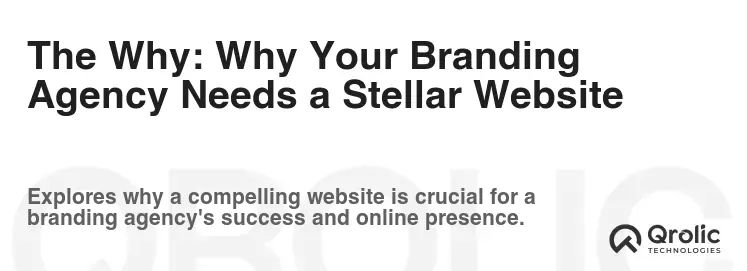
A website isn’t just an online brochure anymore. For a branding agency, it’s your digital storefront, your most persuasive salesperson, and your central hub for attracting, engaging, and converting potential clients. It’s where first impressions are forged, where your brand story unfolds, and where trust is built – or broken. Before diving into the “how,” let’s solidify why your website is critically important:
- First Impressions Matter (Immensely): Think of your website as the first handshake. In today’s fast-paced digital world, you have mere seconds to capture a visitor’s attention. A poorly designed, slow-loading, or confusing website sends the message that your agency is unprofessional, out of touch, or simply doesn’t care. A polished, intuitive, and visually appealing site, on the other hand, instantly communicates competence, creativity, and attention to detail.
- Showcase Your Expertise (Don’t Just Tell): Clients aren’t just looking for words; they’re looking for proof. Your website is the perfect platform to showcase your best work. High-quality case studies, compelling portfolio pieces, and impactful testimonials provide concrete evidence of your capabilities and the value you bring to the table. Demonstrate, don’t just claim.
- Establish Authority and Trust: In the branding world, trust is everything. Your website is where you can establish yourself as a thought leader in the industry. Share insightful blog posts, publish helpful resources, and demonstrate your understanding of branding principles and market trends. Position yourself as the go-to expert that clients can rely on.
- Generate Leads and Drive Conversions: Ultimately, your website should be a lead generation machine. Clearly defined calls to action (CTAs), strategic contact forms, and valuable lead magnets (e.g., a free branding guide) can help you capture visitor information and turn them into qualified leads. Make it easy for potential clients to reach out and start a conversation.
- Control Your Narrative: In the digital age, you don’t get to control everything about your brand’s perception, but your website is the one place where you absolutely control the narrative. It’s your opportunity to define your brand values, communicate your unique selling proposition, and tell your story in a way that resonates with your target audience.
- 24/7 Availability: Your website works tirelessly around the clock, showcasing your work and generating leads even when you’re sleeping. It’s your always-on brand ambassador.
The What: Essential Elements of a High-Performing Branding Agency Website
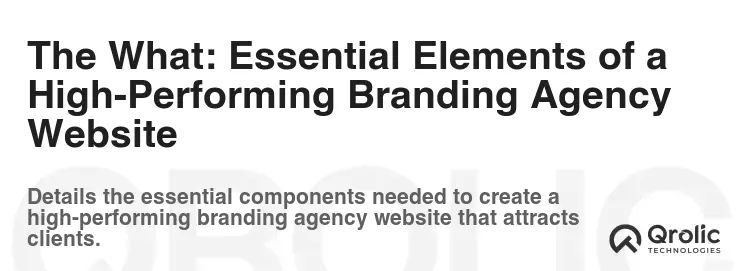
Now that we’ve established the importance of a great website, let’s break down the essential elements that every branding agency website should include:
1. Stunning Visual Design (Creative Web Design is Key)
- Clean and Modern Aesthetics: Embrace minimalism. Avoid clutter and distractions. Use ample white space to create a clean and visually appealing layout. Focus on high-quality imagery and typography.
- Brand-Consistent Design: Your website should be a seamless extension of your brand. Use your brand colors, fonts, and imagery consistently throughout the site. Maintain a unified brand voice and tone.
- High-Quality Photography and Videography: Invest in professional photography and videography. Showcase your team, your office space, and your work in the best possible light.
- Interactive Elements: Consider incorporating interactive elements like animations, micro-interactions, and parallax scrolling to enhance user engagement.
- Mobile-First Approach: Design for mobile first. Ensure your website is fully responsive and looks great on all devices, from smartphones to tablets to desktops. Google prioritizes mobile-friendly sites in search rankings.
2. Compelling Content (Show, Don’t Just Tell)
- Homepage Headline: Your homepage headline should immediately grab the visitor’s attention and clearly communicate your agency’s value proposition. What do you do? Who do you serve? What makes you different?
- Clear Value Proposition: State your value proposition clearly and concisely throughout the website. Focus on the benefits you provide to your clients, not just the features of your services. Answer the question, “Why should I choose you?”
- Case Studies (Detailed and Impactful): Case studies are the cornerstone of your portfolio. Provide detailed descriptions of your projects, including the challenges, your approach, and the results you achieved. Use visuals (before and after shots, mockups, etc.) to bring your work to life. Quantify your results whenever possible (e.g., “Increased website traffic by 50%,” “Improved conversion rate by 20%”).
- Portfolio: Showcase your best work in a visually appealing and easy-to-navigate portfolio. Categorize your work by industry or service type to help visitors find what they’re looking for.
- About Us Page (Humanize Your Brand): Tell your agency’s story. Introduce your team. Share your values and mission. Showcase your company culture. Humanize your brand and connect with visitors on a personal level.
- Services Page (Clearly Defined Offerings): Clearly outline the services you offer. Provide detailed descriptions of each service, including the process, the deliverables, and the benefits.
- Blog (Establish Thought Leadership): Create a blog and publish high-quality content that is relevant to your target audience. Share your insights on branding, marketing, design, and other related topics. Use your blog to establish yourself as a thought leader and drive traffic to your website.
- Testimonials (Build Trust): Include testimonials from satisfied clients throughout your website. Use real quotes and photos to add credibility. Video testimonials are even more impactful.
- Clear Calls to Action (CTAs): Include clear and compelling calls to action throughout your website. Tell visitors what you want them to do (e.g., “Get a free quote,” “Download our guide,” “Contact us today”). Use action-oriented language and make your CTAs visually prominent.
3. User-Friendly Navigation (Intuitive and Seamless)
- Simple and Intuitive Menu: Use a clear and concise menu that makes it easy for visitors to find what they’re looking for.
- Logical Site Structure: Organize your content in a logical and intuitive way. Use breadcrumbs to help visitors navigate the site.
- Search Functionality: Include a search function to allow visitors to quickly find specific information.
- Fast Loading Speed: Optimize your website for speed. Use image compression, caching, and other techniques to ensure your website loads quickly. Slow loading speeds can frustrate visitors and hurt your search engine rankings. Google PageSpeed Insights is a valuable tool.
- Mobile Optimization: Ensure your website is fully responsive and provides a seamless user experience on all devices.
- Accessibility: Design your website with accessibility in mind. Follow WCAG (Web Content Accessibility Guidelines) to ensure your website is usable by people with disabilities.
4. Strong SEO (Search Engine Optimization)
- Keyword Research: Identify the keywords that your target audience is using to search for branding agencies. Use keyword research tools like Google Keyword Planner, Ahrefs, or SEMrush. Consider keywords like “branding agency [location],” “brand strategy,” “logo design services,” and “[industry] branding.”
- On-Page Optimization: Optimize your website’s content for your target keywords. Use keywords in your page titles, meta descriptions, headings, and body text. Don’t stuff keywords; focus on creating high-quality, relevant content.
- Off-Page Optimization: Build backlinks from other high-quality websites. Guest blogging, directory listings, and social media promotion can help you build backlinks and improve your search engine rankings.
- Technical SEO: Ensure your website is technically sound. Use a sitemap, robots.txt file, and schema markup to help search engines crawl and index your website. Fix broken links and ensure your website is mobile-friendly.
- Local SEO: If you serve a local market, optimize your website for local search. Create a Google My Business listing and include your address, phone number, and website URL on your website. Get local citations from other websites.
- Content Marketing: Consistently create and publish high-quality content that is optimized for search engines. Blog posts, articles, infographics, and videos can all help you attract traffic and improve your search engine rankings.
5. Lead Capture and Conversion Optimization
- Contact Forms: Make it easy for visitors to contact you. Include contact forms on your website, and ensure they are easy to fill out and submit.
- Landing Pages: Create dedicated landing pages for your services and target keywords. Landing pages should be optimized for conversions and include a clear call to action.
- Lead Magnets: Offer valuable lead magnets (e.g., a free branding guide, a checklist, a template) in exchange for visitor contact information.
- Live Chat: Consider adding live chat to your website to provide real-time support to visitors and answer their questions.
- A/B Testing: Continuously test different elements of your website (e.g., headlines, CTAs, layouts) to see what works best for conversions.
- Analytics Tracking: Use Google Analytics to track your website’s performance and identify areas for improvement. Track your traffic, conversions, and other key metrics.
The How: Steps to Creating Your Branding Agency Website
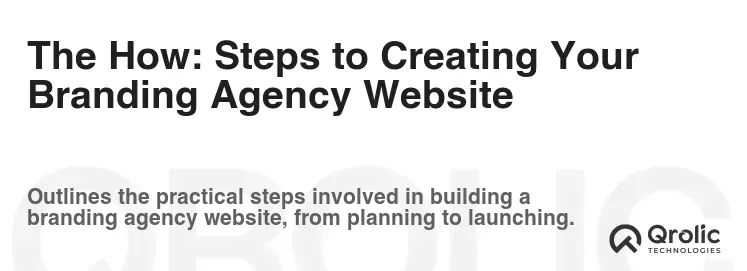
Now, let’s get into the practical steps you’ll need to take to create your branding agency website:
Step 1: Planning and Strategy
- Define Your Target Audience: Who are you trying to reach with your website? What are their needs, wants, and pain points?
- Set Your Goals: What do you want your website to achieve? Do you want to generate leads, build brand awareness, or showcase your work?
- Develop Your Brand Messaging: What is your unique selling proposition? What are your brand values? What is your brand voice?
- Conduct Competitor Research: Analyze your competitors’ websites. What are they doing well? What could they be doing better?
- Create a Sitemap: Plan the structure of your website. How will your content be organized? What pages will you include?
- Choose a Domain Name: Select a domain name that is relevant to your brand and easy to remember.
Step 2: Design and Development
- Choose a Platform: Select a website platform that is right for you. Popular options include WordPress, Webflow, Squarespace, and Wix. WordPress offers flexibility and SEO capabilities, while Webflow caters to designers with its visual interface.
- Select a Theme or Template (or Design from Scratch): Choose a theme or template that is visually appealing and suits your brand. Alternatively, you can design your website from scratch. For branding agencies, custom design often conveys expertise better.
- Develop Your Content: Create compelling and informative content for your website. Write clear and concise copy that is optimized for search engines.
- Design Your Pages: Design the layout and visual elements of each page on your website. Ensure your website is mobile-friendly and easy to navigate.
- Develop Functionality: Add any necessary functionality to your website, such as contact forms, a blog, or an e-commerce store.
- Test Thoroughly: Test your website thoroughly to ensure it is working properly. Check for broken links, spelling errors, and other issues.
Step 3: SEO and Optimization
- Keyword Research: Identify the keywords that your target audience is using to search for branding agencies.
- On-Page Optimization: Optimize your website’s content for your target keywords.
- Off-Page Optimization: Build backlinks from other high-quality websites.
- Technical SEO: Ensure your website is technically sound.
- Local SEO: If you serve a local market, optimize your website for local search.
- Speed Optimization: Optimize your website images and code for faster loading times
Step 4: Launch and Promotion
- Launch Your Website: Make your website live!
- Promote Your Website: Promote your website through social media, email marketing, and other channels.
- Monitor Your Website’s Performance: Track your website’s performance using Google Analytics. Identify areas for improvement.
Step 5: Maintenance and Updates
- Keep Your Website Up-to-Date: Regularly update your website with fresh content.
- Fix Broken Links: Check for broken links and fix them promptly.
- Update Your Software: Keep your website software (e.g., WordPress, plugins) up-to-date.
- Monitor Your Security: Monitor your website for security vulnerabilities and take steps to protect it from hackers.
- Adapt to Change: Stay up-to-date with the latest web design trends and technologies. Be prepared to adapt your website as needed.
Advanced Strategies for a Standout Branding Agency Website
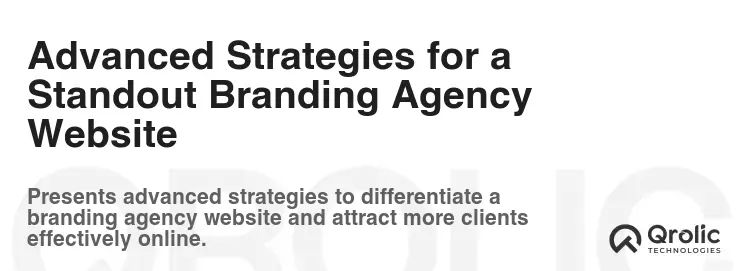
Once you’ve covered the basics, consider these advanced strategies to truly differentiate your agency’s website:
- Interactive Case Studies: Move beyond static text and images. Embed interactive elements within your case studies, such as before-and-after sliders, 3D models, or virtual tours.
- Personalized User Experiences: Use data to personalize the user experience. For example, you could display different content to visitors based on their industry or location.
- AI-Powered Chatbots: Implement an AI-powered chatbot to provide instant support and answer common questions. This can free up your team to focus on more complex inquiries.
- Augmented Reality (AR) Experiences: If you offer services like packaging design, consider incorporating AR experiences that allow users to visualize your designs in the real world.
- Accessibility as a Differentiator: Go above and beyond basic accessibility guidelines. Showcase your commitment to inclusivity and cater to a wider audience.
- Gamification: Incorporate gamified elements to engage visitors and encourage them to explore your website. For example, you could award points for completing tasks or offer badges for achieving milestones.
- Video Marketing Masterclass: Create a series of high-quality videos that showcase your expertise, share client success stories, and offer valuable insights into the world of branding. Host these videos on your website and promote them across social media.
- Thought Leadership Hub: Develop a comprehensive thought leadership hub that features your latest articles, white papers, webinars, and podcasts. Position yourself as a trusted source of knowledge and attract potential clients who are seeking expert guidance.
Common Mistakes to Avoid
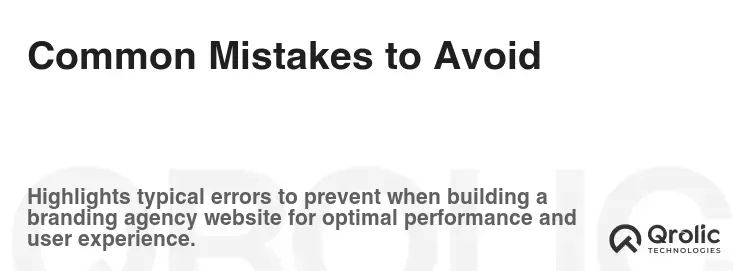
Creating a successful branding agency website requires careful planning and execution. Here are some common mistakes to avoid:
- Generic Design: A generic website fails to communicate your agency’s unique personality and brand identity. Invest in a custom design that reflects your values and sets you apart from the competition.
- Lack of Mobile Optimization: In today’s mobile-first world, a non-responsive website is a major turnoff. Ensure your website is fully optimized for all devices.
- Slow Loading Speeds: Slow loading speeds can frustrate visitors and hurt your search engine rankings. Optimize your website for speed by compressing images, leveraging browser caching, and using a content delivery network (CDN).
- Poor Navigation: Confusing navigation can make it difficult for visitors to find what they’re looking for. Use a clear and intuitive menu structure, breadcrumbs, and a search function to help users navigate your website.
- Ignoring SEO: Failing to optimize your website for search engines can significantly limit its visibility. Conduct keyword research, optimize your content, and build backlinks to improve your search engine rankings.
- Neglecting Analytics: Without analytics, you won’t know how your website is performing or where you can improve. Use Google Analytics to track your website’s traffic, conversions, and other key metrics.
The Cost: Investing in Your Digital Presence
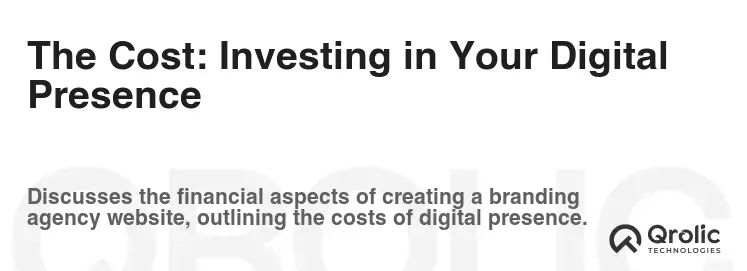
The cost of creating a branding agency website can vary widely depending on several factors, including:
- Design Complexity: Custom designs will generally cost more than using a pre-designed template.
- Development Costs: The complexity of your website’s functionality will impact development costs.
- Content Creation: Hiring professional copywriters and photographers can add to the overall cost.
- SEO and Marketing: Investing in SEO and marketing services can help you attract more traffic and generate leads.
While it’s tempting to cut corners, remember that your website is a crucial investment in your agency’s future. A well-designed, optimized, and maintained website can generate leads, build brand awareness, and ultimately drive revenue.
How Qrolic Technologies Can Help
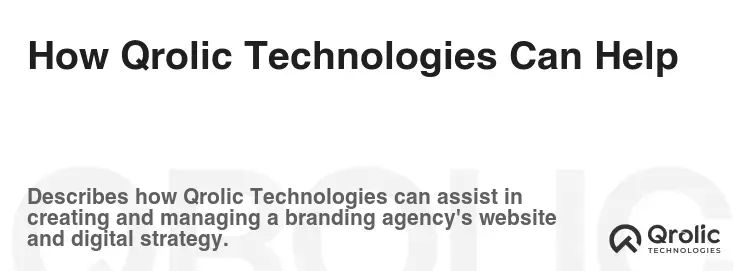
At Qrolic Technologies (https://qrolic.com/), we understand the unique challenges and opportunities facing branding agencies in the digital landscape. We offer a comprehensive suite of services to help you create a website that truly represents your brand and achieves your business goals.
- Creative Web Design: Our team of experienced designers can create a custom website that reflects your brand identity and captivates your target audience.
- Web Development: We build websites that are not only visually stunning but also technically sound, responsive, and optimized for performance.
- SEO Optimization: Our SEO experts can help you improve your website’s search engine rankings and attract more organic traffic.
- Content Marketing: We can create engaging and informative content that resonates with your target audience and establishes you as a thought leader in the industry.
- Digital Marketing: Our digital marketing services can help you promote your website and reach a wider audience.
We’re passionate about helping branding agencies succeed online. Contact us today to learn more about how we can help you create a website that drives results.
The Future: Trends Shaping Branding Agency Websites
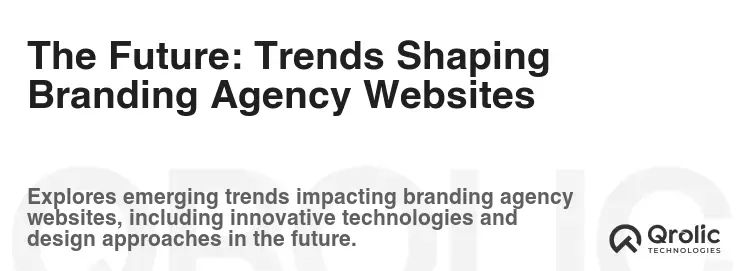
The digital landscape is constantly evolving, and branding agency websites must adapt to stay ahead of the curve. Here are some emerging trends to watch:
- AI-Powered Personalization: Expect to see more websites using AI to personalize the user experience based on individual preferences and behaviors.
- Voice Search Optimization: As voice search becomes more prevalent, optimizing your website for voice queries will be crucial.
- Web3 Integration: Some agencies are beginning to explore Web3 technologies like blockchain and NFTs to create unique and engaging experiences.
- Sustainable Web Design: With growing awareness of environmental issues, sustainable web design practices (e.g., reducing website energy consumption) will become increasingly important.
- Focus on User Experience (UX): A seamless and intuitive user experience will be paramount. Agencies will prioritize user-centered design and strive to create websites that are enjoyable and easy to use.
Conclusion: Your Website – The Heart of Your Brand
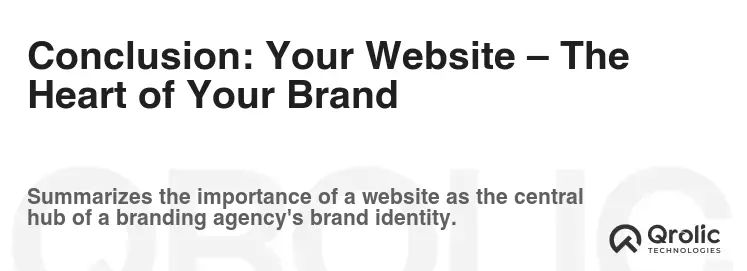
Creating a high-performing branding agency website is an ongoing process, not a one-time project. By investing in a well-designed, optimized, and maintained website, you can establish your agency as a leader in the industry, attract new clients, and achieve your business goals. Remember to prioritize user experience, focus on creating compelling content, and continuously adapt to the ever-changing digital landscape. Your website is more than just a digital brochure; it’s the heart of your brand.






